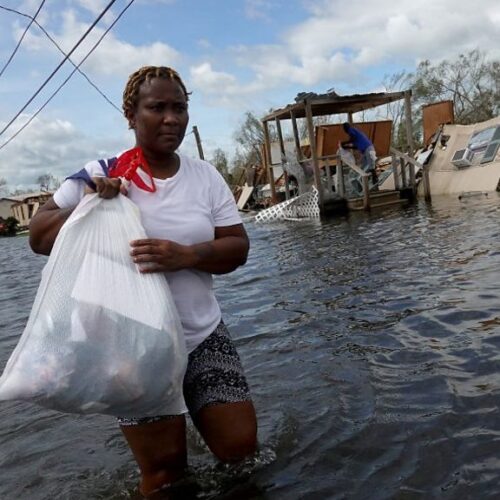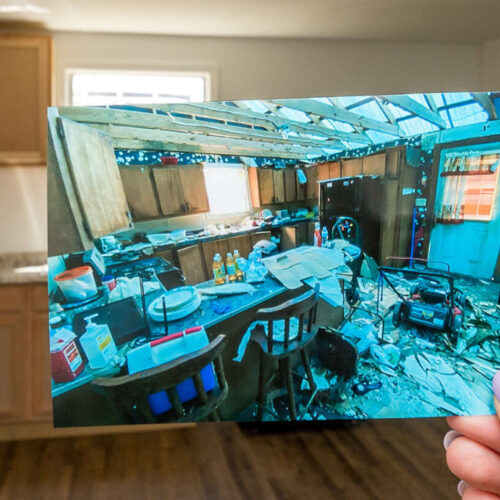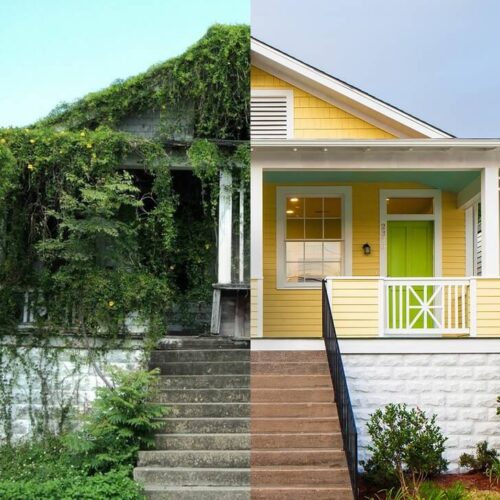By: Grace Daniels, Jim He, Yu Kunita, and Spencer Oliver
On August 31st of 2005, Hurricane Katrina (Category 5) took approximately 2000 lives spanning the city of New Orleans and the Gulf Coast region, and cost over $100 billion in damages. Sixteen years later on August 26th of 2021, Hurricane Ida (Category 4) struck and caused $75 billion in damage. These disasters have deep and lasting impacts on the city and culture of New Orleans, as pre-Katrina (2005) population levels dropped from 454,800 to 208,700 in the year following the disaster.
Post-Katrina proved to be a pivotal era to the future of The Big Easy. 95,000 New Orleans residents left or lost their jobs during the 12 months following the hurricanes. Katrina’s repercussions left hundreds of thousands homeless: 1.5 million residents of Louisiana, Mississippi, and Alabama evacuated before, and only 60% of those residents returned after Hurricane Katrina.

Hurricane Ida, 2021. (Photo credit: BBC)
New Orleans returning residents came “home” to a spike in home prices, poverty decentralization, and complete destruction of the four major housing projects in downtown New Orleans. Returning New Orleans residents faced two options: migrate to urban Louisiana or stay in FEMA’s 45,000 housing units that contained treacherous sums of formaldehyde gas. Combined and concerted efforts by the federal, state, and city governments boosted recovery efforts and enabled the population to bounce back, but it is inarguable that the city has never fully recovered ever since.
When Ida hit, comparisons were drawn between the current devastation and Hurricane Katrina as over one million people faced energy and clean water shortages in the following weeks. These disaster events, in the broad scope of their damage, had the ability to artificially manipulate the economy of the Gulf Coast via recovery efforts and homeownership subsidy programs, with Katrina bringing in $41.1 billion in insurance claim payments and Ida bringing $9.8 billion. This article addresses the economic impacts of natural disasters on the city of New Orleans and disaster recovery efforts as both a necessary step towards rebuilding a community and a potential threat to the affordability and culture of New Orleans neighborhoods.
The concept of gentrification has received an immense amount of attention in recent decades from academics, politicians, and the general public alike; for the sake of clarity and continuity, this article will rely on the following as key indicators of gentrification:
Using the above metrics in qualifying the degree of gentrification in a given area, it becomes clear that Katrina was a catalyst for gentrification across the city, but most notably in areas with the highest severity of storm-related damage. Scholars argue that this may be the case in part due to the artificial inflation of the local economy due to government intervention and investment efforts. The mere fact that the government invested, compounded with the high price of construction materials post-Katrina, could explain the rise in housing prices and, consequently, the aforementioned gentrification. However, it is important to note that this government investment is almost entirely directed to recovery efforts (90)%, rather than focusing on resilience. Non-profit organizations such as the St. Bernard Project have stepped in and provided disaster-related support, notably in resilient home-improvement initiatives.

Before and after photo of SBP renovation work. (Photo credit: SBP)
Climate gentrification (CG) is a term used to describe the impacts that disruptive climatic events have on the housing market, often resulting in the involuntary displacement of individuals with lower income, lower socioeconomic status, lower educational status, etc. Theories of CG imply that locales with a propensity towards such intense natural disasters – such as New Orleans and its surrounding communities – are vulnerable to an out-migration of lower-income residents as the cost burden of living in such an environment rises above their feasible financial capacities. This fundamental idea of a climate-related disaster and the subsequent recovery efforts as transformational in the character and demographic of a community is maintained in studies across disaster-impacted housing markets (i.e., Orleans Parish, Miami-Dade County, etc.). This phenomenon has already taken hold in New Orleans following the devastation and recovery efforts of Hurricane Katrina. Neighborhoods in New Orleans that were geographically and topographically beneficial, populated with lower-income, and more racially diverse communities were primed for climate gentrification, as described by Keenan et al. in their study of MDC.
To further complicate matters, there is evidence suggesting that communities that are proactive in preventing disaster-related damage through resiliency initiatives prime themselves for what is called Green Gentrification – the rising cost of living associated with an increased value of properties fortified against climate/weather-related damage. This creates a double-edged sword of community recovery efforts; one finds themselves contributing to gentrifying forces through resiliency initiatives but also by allowing the current vulnerability to continue and damage to be incurred.

Home abandoned after Hurricane Katrina, renovated for new tenants. (Photo credit: Redmellon Restoration & Development)
Managing the balance between recovery, resilience, and a socially integrated and affordable environment is of critical importance, yet receives little attention from the volunteer organizations who step in to provide critical aid to devastated communities. The work of these organizations must be critically analyzed in terms of both the short- and long-term community impacts. Providing support to disaster-stricken communities is a social and economic necessity, but should be done with sensitivity and awareness so as to not damage the community further with the deep impacts of gentrification.
For more information on the St. Bernard Project and their work, please visit their website.
This piece was edited by Anna Blavatnik as part of Professor Kelley Crawford’s Digital Civic Engagement course at Tulane University.
 NOLAbeings Multimedia artist Claire Bangser created NOLAbeings as a portrait-based story project that marries...
NOLAbeings Multimedia artist Claire Bangser created NOLAbeings as a portrait-based story project that marries...  Voodoo in New Orleans: Reviving history: New Orleans fortune telling This article takes a deep dive into the history of Voodoo in New Orleans, its hybridization with Catholicism, and its present-day place in the city's culture. The author visits fortune-tellers in the French Quarter, using their guidance as a tool for introspection rather than a deterministic predictor of the future. Through her experiences in New Orleans, the author feels a mystical connection to both the past and the future.
Voodoo in New Orleans: Reviving history: New Orleans fortune telling This article takes a deep dive into the history of Voodoo in New Orleans, its hybridization with Catholicism, and its present-day place in the city's culture. The author visits fortune-tellers in the French Quarter, using their guidance as a tool for introspection rather than a deterministic predictor of the future. Through her experiences in New Orleans, the author feels a mystical connection to both the past and the future. 